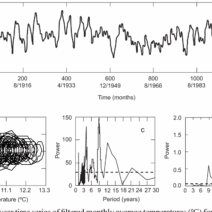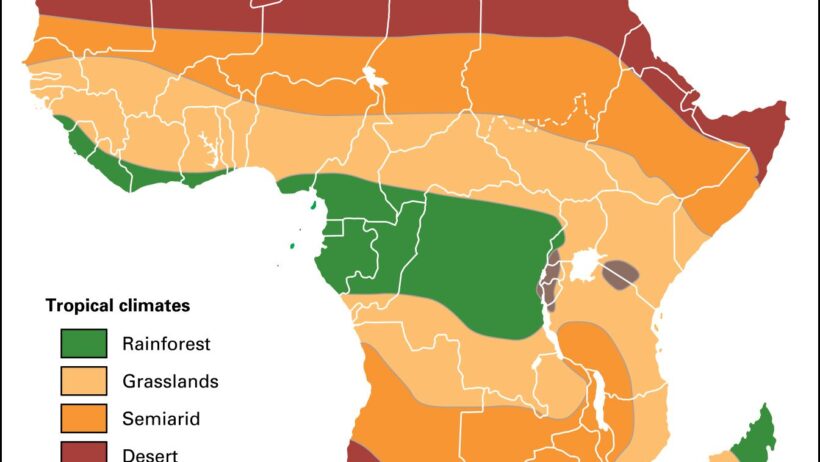A continent steeped in a rich tapestry of climatic variability, Africa presents a panoramic view of ecosystems that are as diverse as its cultures. A sketch map of Africa reveals not merely geographical boundaries, but the intricate interplay between topography, hydrology, and atmospheric dynamics that mold its climatic regions. Understanding these diverse climates is pivotal not only for ecological prospects but also for economic viability, human health, and sustainable development across the continent.
At the heart of Africa’s climatic diversity lies the Horn of Africa, an area characterized by arid and semi-arid conditions. Here, the Somali Peninsula relentlessly confronts the Indian Ocean, which plays a crucial role in determining rainfall patterns. In this region, the monsoon-like climate is influenced heavily by the seasonal movement of the Intertropical Convergence Zone (ITCZ). This climatic phenomenon results in short yet intense rainy seasons, punctuated by lengthy dry spells that define pastoral lifestyles and agricultural practices. The challenges posed by this climate, such as drought and food insecurity, demand innovative adaptive strategies to mitigate their adverse effects.
Moving westward, one encounters the Sahel, a transitional zone between the Sahara Desert to the north and the more tropical climates to the south. This semi-arid region is marked by a precarious balance between drought and flooding. The Sahel is emblematic of climate change’s impacts, witnessing extreme weather events that threaten livelihoods. The vast expanse, dotted with scrub and grassland, holds immense potential but is hampered by inconsistent rainfall and soil degradation. Initiatives aimed at sustainable land management and reforestation must be prioritized to reclaim the Sahel’s ecological vitality.
To the north, the Sahara, the world’s largest hot desert, presents an extreme climatic condition. Here, high temperatures and minimal rainfall create an arid environment, shaping landscapes of sand dunes and rocky plateaus. Despite its inhospitable nature, the Sahara is not devoid of life. Nomadic tribes have adeptly adapted to harsh conditions, finding sustenance within this imposing terrain. However, the desert’s challenges are exacerbated by climate change, as rising temperatures further threaten water sources, necessitating urgent dialogues about water resource management and conservation strategies.
Heading south into the savanna regions, a remarkable transformation emerges. The African savanna, characterized by grasslands interspersed with sporadic trees, boasts a humid subtropical climate. This area is particularly renowned for its biodiversity, hosting iconic wildlife such as elephants, lions, and giraffes. The savanna’s climate features distinct wet and dry seasons, governed by the movement of the ITCZ, which creates an ecosystem teeming with life. The interplay between flora and fauna in these regions is essential for ecological balance, making conservation efforts imperative in the face of habitat loss and climate variability.
Transitioning further south, the East African Highlands arise, defined by their mountainous topography and a mix of temperate and tropical climates. This area includes countries such as Ethiopia and Kenya, where elevation plays a crucial role in climate formation. The highlands experience cooler temperatures and significant rainfall, fostering rich biodiversity and fertile soils. These conditions are integral for agriculture, particularly the cultivation of coffee and tea – key economic drivers in the region. However, the rising risks associated with climate change, such as erratic rainfall patterns and rising temperatures, threaten agricultural productivity, necessitating adaptive measures to safeguard food security.
In contrast, the coastal regions along the Atlantic and Indian Oceans offer a different climatic experience characterized by humid maritime climates. The West African coastline experiences tropical climates with abundant moisture, fostering rich ecosystems and fishing industries. The coastal areas in countries like Ghana and Nigeria are critical for economic activities, driven by agriculture and maritime resources. Moreover, the coastlines serve as biodiversity hotspots, crucial for ecological health. The threats from rising sea levels due to climate change place these coastal ecosystems at significant risk, thereby calling for integrated coastal zone management and sustainable practices.
As the map of Africa unfolds, one cannot overlook the impact of climate on human health and socio-economic conditions. Areas affected by prolonged droughts, like those in the Sahel and parts of Southern Africa, face challenges such as food insecurity and health crises linked to malnutrition. Additionally, the spread of vector-borne diseases like malaria is influenced by climatic conditions, necessitating regional healthcare policies that take climate into account. The interconnections between climate and health underscore the need for a multi-faceted approach to tackle potential vulnerabilities arising from climate change.
Furthermore, urbanization trends across Africa introduce another layer of complexity to the continent’s climatic landscape. Rapid urban growth exacerbates issues related to climate change, including increased greenhouse gas emissions and heat island effects. Cities like Lagos and Nairobi grapple with these challenges, urging the need for sustainable urban planning that incorporates climate resilience strategies. Engaging local communities and stakeholders in devising these strategies is crucial for fostering sustainable urban environments.
In conclusion, a sketch map of Africa not only delineates geographical boundaries but intricately weaves together diverse climatic regions, each carrying profound implications for the environment, economy, and society. As climate change continues to alter these dynamics, it is imperative to foster a comprehensive understanding of Africa’s climatic diversity. By prioritizing sustainable practices, embracing technological innovations, and promoting adaptive strategies, Africa can navigate the nexus of climate change and development, ensuring a resilient and sustainable future for all its inhabitants.







